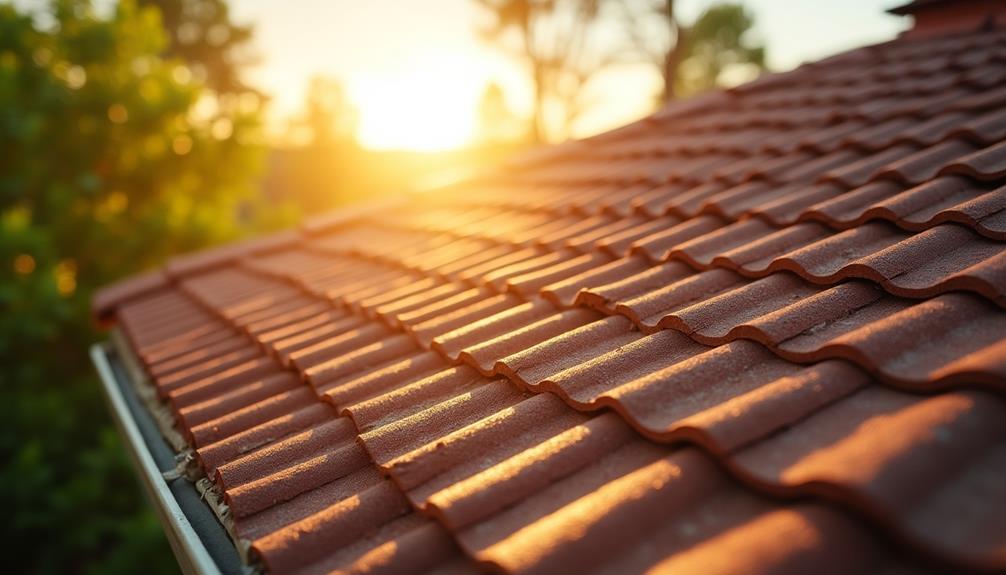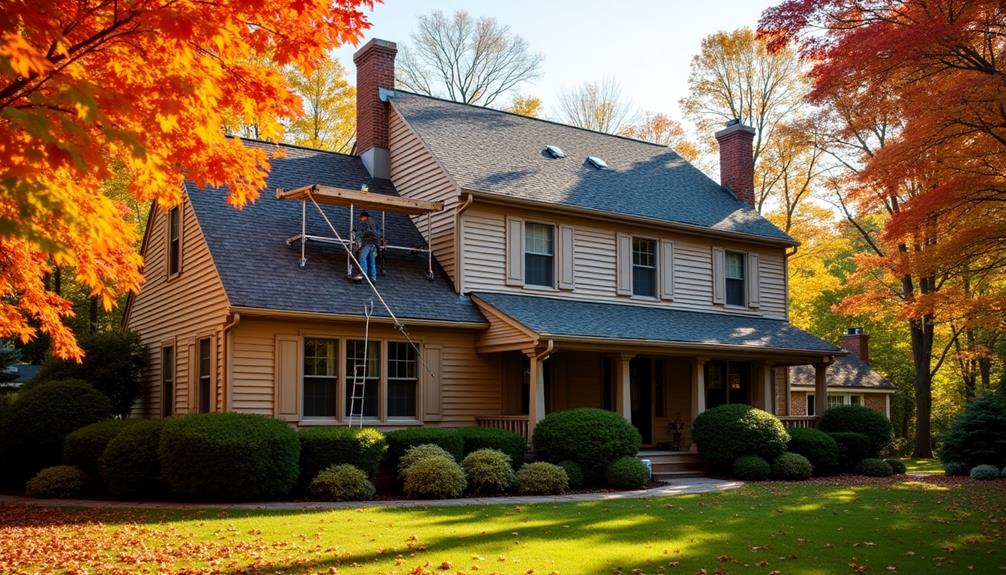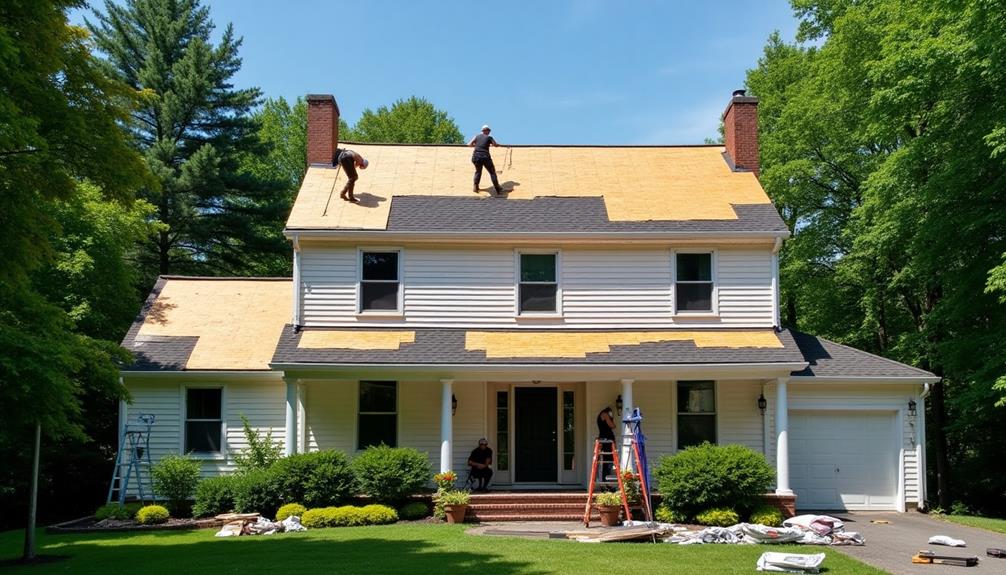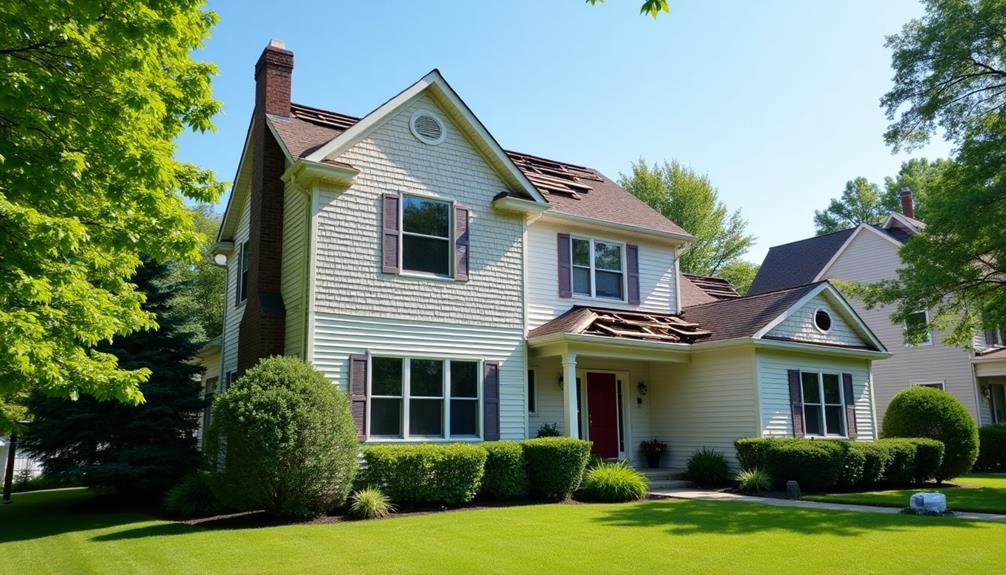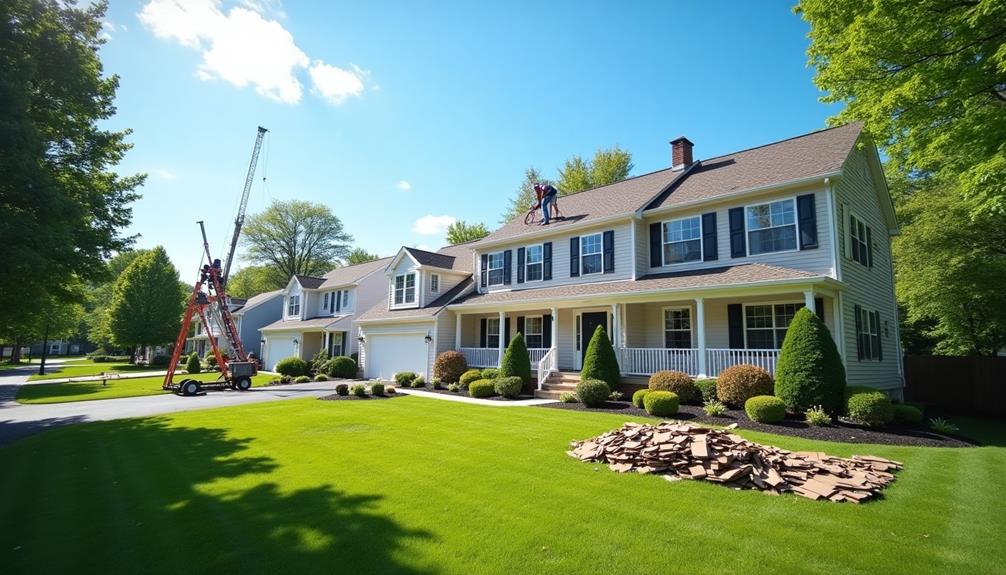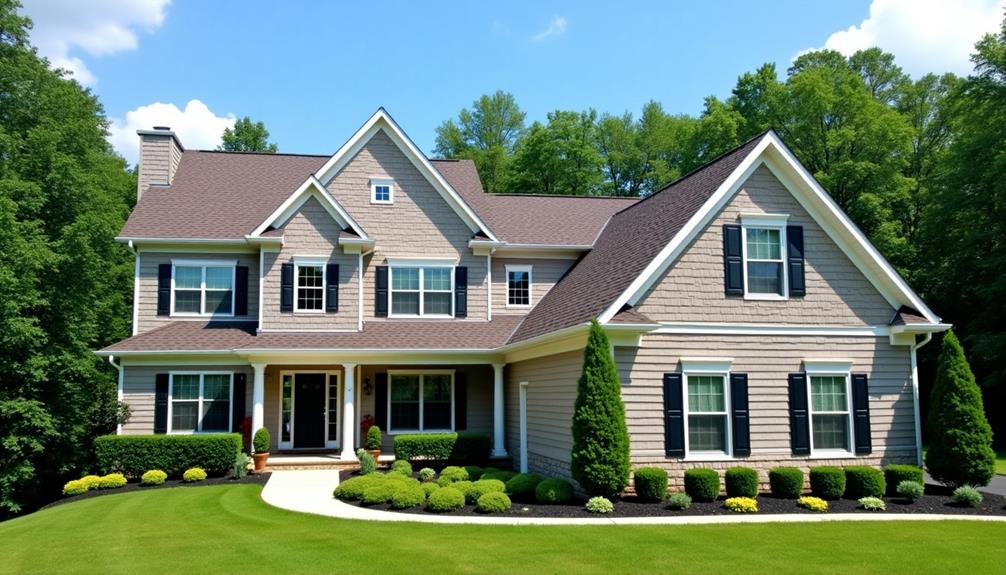To prevent roof shingle damage from UV rays, adopt a proactive approach. Start by choosing UV-resistant materials like fiberglass or specially treated asphalt shingles. Regularly inspect your roof for signs of wear, such as fading or cracking, at least twice a year. Apply reflective coatings to minimize heat buildup and UV exposure. Ensure proper attic ventilation to reduce shingle warping. Trim overhanging branches to avoid debris accumulation and moisture issues. Installing a high-quality underlayment also adds protection. For optimal results, consider enlisting a qualified professional to enhance your roof's durability and effectiveness. Explore further to discover additional prevention strategies.
Understand UV Rays and Shingles
Understanding how UV rays impact your roof shingles is crucial for maintaining their integrity. UV radiation from the sun can lead to significant deterioration of shingle materials over time. When shingles are exposed to these rays, the UV impact accelerates the breakdown of their structural components, causing them to become brittle and less effective at protecting your home.
As shingles degrade due to UV exposure, their color can fade, and they may develop cracks or splits. This deterioration not only affects the aesthetic appeal of your roof but also shortens the shingle lifespan. A compromised roof can lead to leaks and other serious structural issues, leading to costly repairs.
To mitigate the effects of UV rays, it's vital to regularly inspect your shingles for signs of wear and damage. If you notice any issues, addressing them promptly can help extend the lifespan of your roof.
Additionally, maintaining proper ventilation and ensuring your roof is kept clean can further reduce UV impact on your shingles. By being proactive, you can protect your investment and ensure your roof remains functional for many years.
Choose UV-Resistant Materials
When selecting materials for your roof, opting for UV-resistant options can significantly enhance its longevity and performance. UV rays can degrade roofing materials over time, leading to premature wear and reduced effectiveness. By choosing shingles specifically designed to withstand UV exposure, you're not just investing in immediate aesthetics but also in long-term durability.
Look for shingles made from materials like fiberglass or specially treated asphalt, which are engineered to resist UV damage. These materials often feature advanced coatings that reflect sunlight rather than absorbing it, mitigating thermal expansion and contraction that can lead to cracking and warping.
Additionally, consider products with higher warranty periods, as manufacturers that offer extended warranties typically back the material performance against UV damage. Always consult product specifications to ensure the shingles meet industry standards for UV resistance.
Regular Roof Inspections
To maintain the integrity of your roof, regular inspections are essential. These inspections help identify potential issues caused by UV rays, such as curling, fading, or cracking. By incorporating a routine inspection schedule, you can implement preventative measures to mitigate damage before it escalates.
Aim for at least two inspections per year—one in the spring and another in the fall. This timing allows you to address any wear and tear that may have developed over the winter or summer months.
During these inspections, look for signs of shingle deterioration, such as granule loss or discoloration, which can indicate UV damage. Additionally, check for algae or moss growth. These organisms can trap moisture, leading to further deterioration.
If you notice any damage, address it promptly, as minor issues can quickly turn into costly repairs if left unchecked. Consider documenting your findings during each inspection, which will help you monitor changes over time and plan for necessary maintenance.
Regular inspections not only prolong the lifespan of your roof but also protect your home's overall value.
Apply Reflective Coatings
Applying reflective coatings to your roof can significantly reduce temperature buildup and protect shingles from harmful UV rays. These specialized coatings work by reflecting solar radiation, thereby lowering surface temperatures and minimizing heat absorption.
When you apply a high-quality reflective coating, you enhance your roof's ability to combat UV damage, extending the lifespan of the shingles.
Before applying the reflective coatings, ensure your roof is clean and free of debris. This preparation is crucial for optimal adhesion and effectiveness. You'll want to choose a coating specifically designed for your roofing material to maximize durability and UV protection.
Once you've applied the coating, monitor its condition regularly. Over time, the effectiveness may diminish due to environmental factors, necessitating reapplication. Look for any signs of wear or peeling; these indicate that your roof may need an update to its protective layer.
Investing in reflective coatings not only improves the roof's resistance to UV rays but also enhances energy efficiency in your home. By keeping your shingles cooler, you can potentially lower cooling costs, making this an economical choice in the long run.
Maintain Proper Ventilation
Proper ventilation is crucial for maintaining the integrity of your roof shingles and preventing damage. When your attic lacks adequate airflow, heat and moisture can accumulate, leading to premature degradation of your shingles. Effective ventilation systems allow for the necessary exchange of air, which helps regulate temperature and moisture levels in the attic.
To ensure optimal attic airflow, you should install a balanced ventilation system that includes both intake and exhaust vents. Intake vents, typically located near the eaves, allow cool air to enter the attic. Exhaust vents, on the roof's peak, enable hot air to escape. This balance prevents heat buildup and reduces the risk of shingle warping or blistering caused by excessive UV exposure.
Regularly inspect your ventilation systems for blockages, such as debris or insulation that could hinder airflow. If you notice any issues, address them promptly to maintain proper ventilation.
Trim Overhanging Branches
Overhanging branches can pose a significant threat to your roof shingles, especially during storms or high winds. When branches sway or break, they can scrape against the shingles, leading to abrasions and potential leaks. Regular branch trimming is essential to prevent this damage.
Moreover, while you may appreciate the shade creation these branches provide, it's crucial to strike a balance. Excessive shade can trap moisture on your roof, promoting the growth of mold and algae, which can deteriorate shingles over time. Therefore, carefully assess the branches near your roof and trim them back to ensure they're at least six feet away from your shingles.
Use sharp pruning tools to make clean cuts, reducing the risk of disease to the tree and ensuring a neat appearance. If the branches are large or difficult to manage, consider hiring a professional arborist. They can't only assist with safe branch trimming but also advise on maintaining the overall health of your trees.
Install a Roof Underlayment
Installing a roof underlayment is crucial for enhancing your roof's durability and protecting it from moisture and temperature extremes.
You'll find various types of underlayment available, each offering unique benefits tailored to different roofing needs.
Understanding the installation techniques will ensure you maximize the effectiveness of this essential layer.
Benefits of Underlayment
A quality roof underlayment acts as an essential barrier that protects your home from moisture and wind damage. One of the primary underlayment benefits is its ability to serve as a moisture barrier, preventing water infiltration that can lead to mold and structural issues.
When you install underlayment, you add an extra layer of protection beneath your shingles, which is crucial, especially in areas prone to heavy rain or snow.
Additionally, underlayment helps to reduce heat buildup in your attic by reflecting UV rays and minimizing thermal transfer. This not only extends the life of your roof shingles but also contributes to improved energy efficiency in your home.
Without proper underlayment, your shingles are more vulnerable to the damaging effects of the sun and storms.
Moreover, underlayment provides a secondary line of defense against wind uplift, which can dislodge shingles during severe weather. When installed correctly, it enhances the overall performance of your roofing system, ensuring that your home remains safe, dry, and energy-efficient.
Investing in quality underlayment is a crucial step in maintaining the integrity of your roof.
Types of Underlayment
Choosing the right roof underlayment is crucial for maximizing your roof's performance and longevity. There are several types of underlayment available, each offering unique benefits.
Felt underlayment, commonly made from fiberglass or asphalt, provides a reliable moisture barrier but may lack in thermal performance compared to other options.
Synthetic underlayment is gaining popularity due to its lightweight and durable nature. It often outperforms felt in terms of moisture resistance and can be installed using various installation methods, including nail-down or peel-and-stick options.
If you're looking for a more advanced choice, breathable underlayment allows moisture vapor to escape while still providing excellent protection against water infiltration.
When making product comparisons, consider the specific needs of your roof and climate. Cost considerations also play a critical role; while synthetic and breathable options may have higher initial costs, their long-term benefits can outweigh these expenses.
Ultimately, selecting the right underlayment type will enhance your roof's durability and efficiency, helping to prevent shingle damage from UV rays and other environmental factors.
Installation Tips & Techniques
Ensuring a proper installation of roof underlayment is essential for maximizing its protective qualities. Start by selecting the right underlayment based on your chosen shingle types. For example, asphalt shingles typically require a felt or synthetic underlayment that can withstand moisture and UV exposure.
When applying the underlayment, follow specific installation techniques to enhance performance. Begin at the eaves of the roof, overlapping each row by at least 4 inches to ensure a watertight seal. Secure the underlayment with roofing nails, placing them 12 inches apart along the edges and 18 inches apart in the field.
Be mindful of weather conditions; dry, calm days are ideal for installation. If you're working with multiple layers, ensure that each layer is installed in the opposite direction to the one above it, which helps prevent water infiltration.
Invest in Quality Installation
Investing in quality installation is crucial for preventing roof shingle damage.
By choosing experienced contractors and using premium materials, you can significantly enhance your roof's durability.
Additionally, ensuring proper ventilation will help maintain optimal conditions and extend the lifespan of your shingles.
Choose Experienced Contractors
When you prioritize quality installation, selecting experienced contractors becomes crucial for preventing roof shingle damage. Experienced contractors possess the necessary qualifications to ensure your roofing project is executed correctly and efficiently. They understand the nuances of different shingle types and their performance under UV exposure, which is vital for longevity.
Before hiring, evaluate contractor qualifications, such as certifications, years in the industry, and references from past projects. This due diligence helps you gauge their expertise and reliability. Contractors with a solid track record can effectively manage project timelines, ensuring that installation occurs promptly and with minimal disruption.
Proper installation techniques directly impact your roof's resistance to UV rays, which can degrade shingles over time. An experienced contractor will follow best practices, such as ensuring proper ventilation and alignment, to maximize the roof's durability.
Ultimately, investing in a qualified contractor can save you money in the long run. You'll reduce the risk of premature shingle damage and the need for costly repairs or replacements.
Use Premium Materials
Over time, the materials you choose for your roof can significantly impact its durability and performance. Investing in premium materials can enhance your roof's resistance to UV rays, extending its lifespan.
Opt for shingles made from high-quality materials, such as fiberglass or polymer-modified asphalt, which offer superior material durability compared to standard options. These materials are designed to withstand harsh weather conditions and resist degradation from sun exposure.
Additionally, pay attention to color selection. Lighter-colored shingles reflect sunlight better, reducing heat absorption and minimizing the risk of thermal cracking. Darker shingles may absorb more heat but can provide aesthetic appeal. Striking a balance between appearance and performance is crucial.
When you choose premium materials, you're not just investing in your roof; you're also safeguarding your home against potential damage. Quality installation plays a vital role, ensuring that these materials perform optimally.
Collaborate with trusted contractors who specialize in using high-grade products and following industry best practices. This approach not only reinforces your roof's defenses against UV rays but also enhances its overall durability and longevity.
Ensure Proper Ventilation
Quality materials alone won't protect your roof if it lacks proper ventilation. Proper airflow design is crucial for maintaining the integrity of your roof and prolonging the life of your shingles. Without adequate ventilation, heat and moisture can build up in your attic, leading to premature shingle deterioration and increased energy costs.
There are various ventilation types you should consider. Ridge vents, soffit vents, and gable vents work together to create a balanced airflow system. Ridge vents allow hot air to escape from the peak of your roof, while soffit vents draw in cooler air from your eaves. Gable vents can enhance ventilation for specific roof designs.
When planning your ventilation system, ensure it's tailored to your roof's size and shape. The goal is to achieve a consistent airflow that minimizes heat buildup and moisture retention.
Regularly inspect your vents for blockages caused by debris or insulation, as these can impede airflow and compromise your roof's performance.
Investing in quality installation and maintaining proper ventilation will safeguard your shingles against UV damage and extend the lifespan of your entire roofing system.
Schedule Professional Maintenance
Scheduling professional maintenance for your roof is essential to prevent shingle damage and extend its lifespan. Regular roof maintenance, conducted by experienced professionals, helps identify and address potential issues before they escalate.
Professional inspections can reveal hidden problems, such as leaks or UV damage, which you might overlook during casual observations. During these inspections, professionals assess not just the shingles but also the underlying structure, flashing, and ventilation systems.
They can provide targeted recommendations to mitigate UV exposure, such as applying protective coatings or installing reflective materials that reduce heat absorption. Furthermore, they'll check for debris accumulation, which can trap moisture and accelerate wear.
It's advisable to schedule these inspections at least twice a year, ideally in the spring and fall. This proactive approach ensures that your roof remains in optimal condition, safeguarding your home against the elements.
Additionally, maintaining a schedule for professional maintenance can be a cost-effective strategy, as it often prevents the need for costly repairs down the line. By committing to regular professional maintenance, you're investing in the longevity and reliability of your roof.

